The 1930s marked a transformative era in hairstyling, where Hollywood glamour met everyday elegance and created timeless looks that continue to captivate modern fashion enthusiasts.
This decade introduced softer, more romantic styles that replaced the sharp bobs of the 1920s, featuring finger waves, Marcel waves, and intricately styled updos that exuded sophistication and femininity.
Whether you’re drawn to the screen siren appeal of Jean Harlow’s platinum waves or the refined elegance of understated victory rolls, 27 Classic 1930s Hairstyles That Bring Vintage Glamour Back offers a comprehensive guide to recreating these iconic looks for contemporary wear.
This article explores the defining characteristics of Depression-era hairstyling, from the essential techniques and tools used during this period to step-by-step instructions for achieving each distinctive style.
You’ll discover how to master finger waves for special occasions, create romantic low buns for everyday elegance, and adapt these vintage styles to suit modern hair types and lengths.
Each hairstyle is presented with detailed descriptions, styling tips, and practical advice that makes vintage glamour accessible to today’s beauty enthusiasts, proving that true style never goes out of fashion.
Contents
- 1 1. The Finger Wave
- 2 2. Marcel Waves
- 3 3. The Side Part with Deep Waves
- 4 4. Pin Curls and Setting Patterns
- 5 5. The Low Chignon
- 6 6. The Victory Roll Predecessor
- 7 7. The Center Part with Sculpted Waves
- 8 8. The Pageboy
- 9 9. The Pompadour Style
- 10 10. Finger Wave Bob
- 11 11. The Hollywood Wave
- 12 12. The Braided Crown
- 13 13. The Deep Side Sweep
- 14 14. The Rolled Updo
- 15 15. The Soft Wave Bob with Curled Ends
- 16 16. The Faux Bob
- 17 17. The High Finger Wave
- 18 18. The Cluster Curl Style
- 19 19. The Asymmetrical Wave
- 20 20. The Wrapped Chignon
- 21 21. The Waterfall Wave
- 22 22. The Sleek Middle Part
- 23 23. The Halo Braid
- 24 24. The Side-Swept Updo
- 25 25. The Soft Brush-Out Wave
- 26 26. The Crown Roll with Curls
- 27 27. The Romantic Low Waves
- 28 Essential Styling Products and Tools
- 29 Adapting 1930s Styles for Modern Hair
- 30 Styling Tips for Long-Lasting Results
- 31 Historical Context and Cultural Significance
- 32 Conclusion
1. The Finger Wave

The finger wave represents the quintessential 1930s hairstyle, characterized by its signature S-shaped waves that rippled elegantly across the head, creating a sculptural, art-deco inspired look.
This technique dominated both high fashion and everyday styling throughout the decade, symbolizing the era’s commitment to polished, meticulously crafted beauty.
- The finger wave technique involves molding damp hair into alternating curves using fingers, combs, and generous amounts of setting lotion to create uniform, ribbon-like waves.
- This style works exceptionally well on short to medium-length hair, particularly on bob cuts that fell between chin and shoulder length.
- The waves were typically created in a forward-facing direction from the crown, flowing toward the face to frame features beautifully.
- Professional hairstylists of the era spent years perfecting this technique, as creating symmetrical, evenly-spaced waves required considerable skill and patience.
- Modern recreations can be achieved using strong-hold gel, a fine-toothed comb, and metal wave clips to hold the pattern while drying.
- The style remained popular throughout the entire decade because it photographed beautifully and maintained its shape throughout long events.
- For authentic results, hair should be combed smooth and flat against the scalp, with each wave crest positioned precisely parallel to the previous one.
2. Marcel Waves
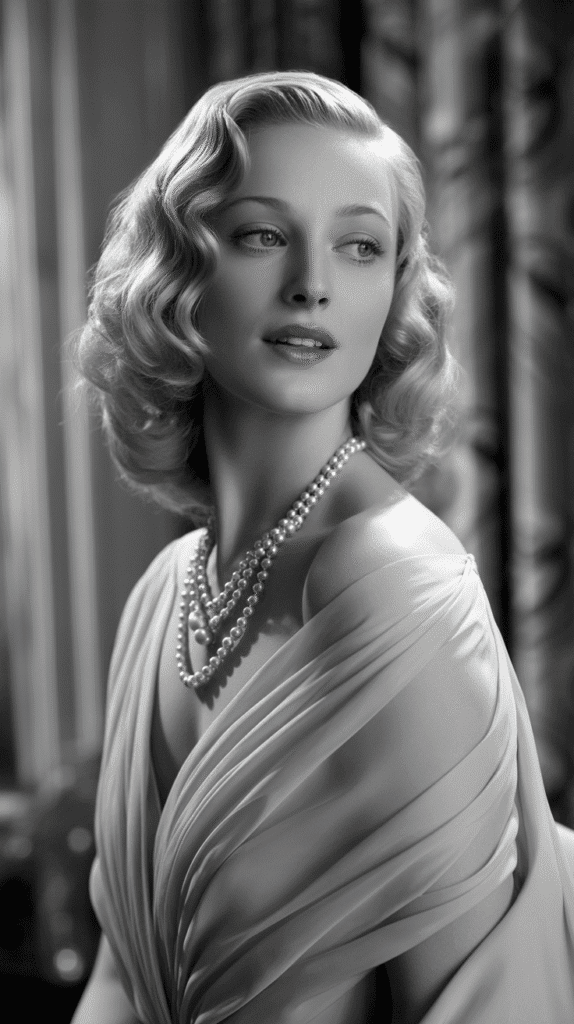
Marcel waves offered a heat-styled alternative to finger waves, created using heated marcel irons that produced deeper, longer-lasting waves with a distinctive rounded shape.
Named after French hairstylist François Marcel Grateau who invented the technique in the 1870s, this method experienced a renaissance during the 1930s.
- Marcel irons were heated over gas flames or electric burners and required expert temperature control to avoid damaging hair while creating lasting waves.
- The resulting waves appeared softer and more natural than finger waves, with a gentle, flowing quality that suited both day and evening wear.
- Professional hairstylists would section hair carefully and work systematically from the nape upward, rotating the iron to create consistent wave patterns.
- This technique worked particularly well on longer hair that extended past the shoulders, allowing waves to cascade romantically down the back.
- The waves created by marcel irons had more volume and body than flat-set finger waves, making them ideal for women with fine or thin hair.
- Modern alternatives include using large-barrel curling irons or waving irons specifically designed to replicate the vintage marcel wave pattern.
- Protective heat sprays and lower temperature settings make this technique safer for contemporary hair that may be chemically treated or colored.
3. The Side Part with Deep Waves
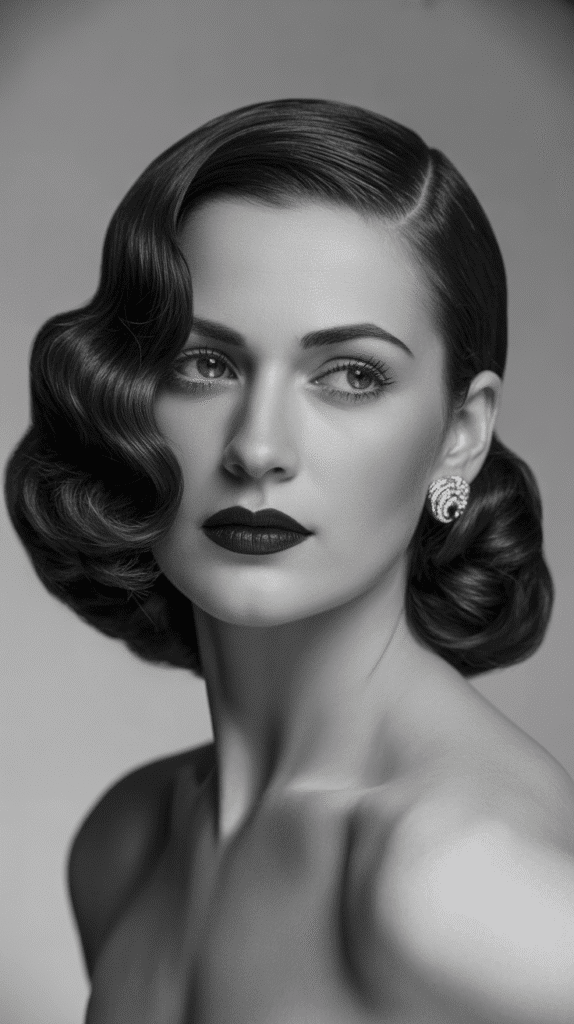
The dramatic side part with deep waves epitomized 1930s sophistication, featuring a severe off-center part with voluminous waves swept dramatically to one side.
This asymmetrical style created visual interest and emphasized facial features while maintaining the era’s signature wave patterns.
- The part was typically placed 2-3 inches from the center, creating a distinct division that added drama and architectural interest to the overall look.
- Hair on the larger section was styled with multiple deep waves that cascaded down, while the smaller section was often pinned flat against the head.
- This style particularly flattered oval and heart-shaped faces by creating balance and drawing attention to the eyes and cheekbones.
- Film stars like Greta Garbo and Marlene Dietrich popularized this look, wearing it both on-screen and at glamorous Hollywood events.
- The deep side part could be combined with various wave patterns, from tight finger waves to loose marcel waves, depending on the desired effect.
- Setting the style required strategic placement of pin curls on the dominant side, often 3-5 rows of overlapping curls to create sufficient volume.
- Modern styling products like volumizing mousse and texturizing spray can help recreate the depth and body characteristic of this vintage look.
4. Pin Curls and Setting Patterns
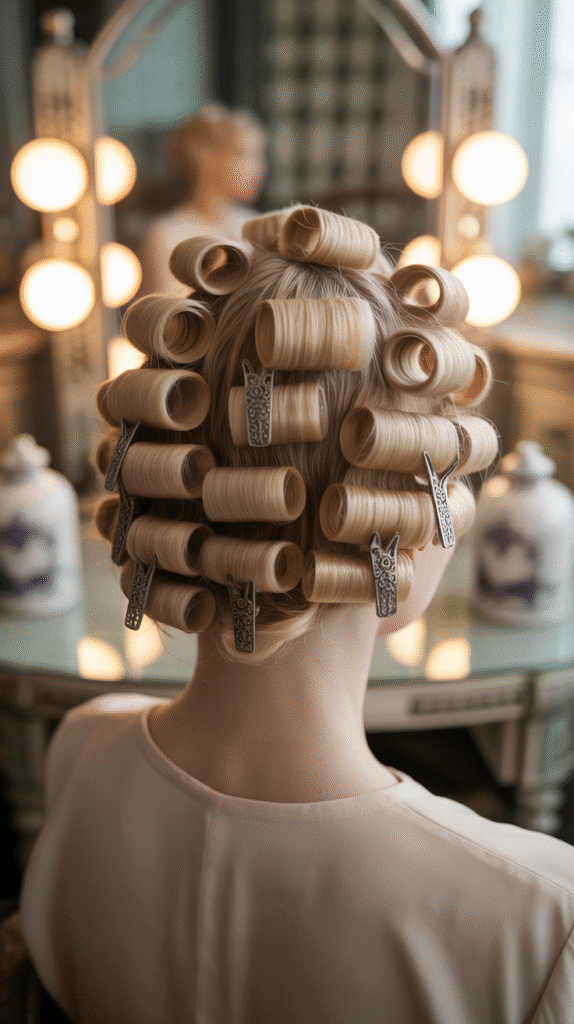
Pin curls formed the foundation of 1930s hairstyling, serving as the setting technique that created the decade’s characteristic waves, volume, and curl patterns.
Understanding proper pin curl placement and direction was essential knowledge for achieving authentic period hairstyles.
- Hairstylists created elaborate setting patterns using dozens of individual pin curls, each carefully positioned to produce specific wave directions and volumes.
- Curls were formed by wrapping small sections of damp hair around fingers, then securing them flat against the scalp with bobby pins or metal clips.
- Forward-facing pin curls created waves that moved toward the face, while reverse pin curls produced waves that moved away from the face.
- The size of each pin curl determined the tightness of the resulting wave, with smaller curls creating tighter patterns and larger curls producing softer waves.
- Hair was typically divided into specific zones—top, sides, back, and nape—with each section receiving a tailored pin curl pattern to achieve the desired final style.
- Setting lotion was applied liberally to damp hair before forming pin curls, ensuring the style would hold for several days when properly maintained.
- Women often slept in pin curls covered by silk scarves or hairnets, then brushed them out the following morning to reveal perfectly formed waves.
5. The Low Chignon
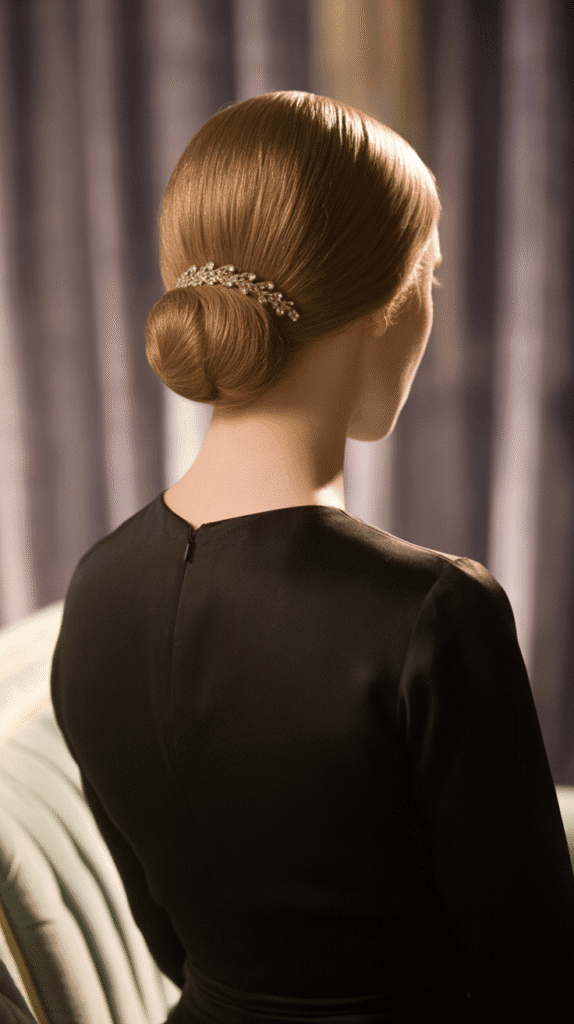
The low chignon represented refined elegance in 1930s hairstyling, featuring hair gathered and arranged in a sophisticated knot or coil positioned at the nape of the neck.
This classic updo suited both daytime propriety and evening glamour depending on how it was executed and accessorized.
- The style began with smooth, flat hair on top, often incorporating side or center parts with gentle waves leading back toward the gathered section.
- Hair was collected at the nape and twisted, coiled, or arranged into various configurations—from simple twisted buns to more elaborate folded and pinned creations.
- This updo particularly suited professional women and matrons who desired sophisticated styles that conveyed respectability and refinement.
- The low positioning of the chignon worked beautifully with the cloche hats and small tilted hats popular during the early 1930s.
- Variations included the figure-eight chignon, the coiled rope chignon, and the pleated chignon, each offering different textural interest.
- For evening wear, chignons were often adorned with jeweled clips, decorative combs, or fresh flowers to add glamorous touches.
- Modern recreations work best on medium to long hair and can be enhanced with hair donuts or padding to create authentic 1930s volume.
6. The Victory Roll Predecessor
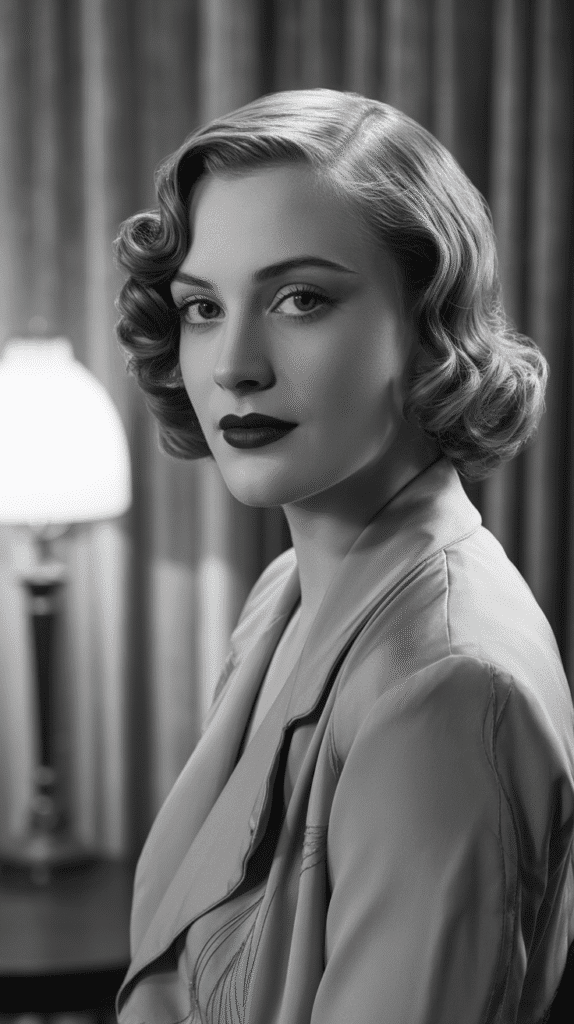
While victory rolls became iconic in the 1940s, their origins trace back to late 1930s styling techniques that featured rolled sections of hair incorporated into updo styles.
These early rolled elements added height, structure, and visual interest to otherwise flat hairstyles.
- Hairstylists began experimenting with rolling front sections of hair backward and upward, creating volume and lift around the hairline and temples.
- These proto-victory rolls were typically smaller and more subtle than their 1940s counterparts, integrated seamlessly into finger wave patterns.
- The technique involved backcombing or ratting hair sections to create interior volume, then smoothing the exterior before rolling and pinning.
- These rolled sections often appeared on just one side of the head, complementing the asymmetrical styling preferences of the decade.
- The rolls were positioned lower on the head than later victory rolls, creating a softer, more romantic silhouette consistent with 1930s aesthetics.
- This styling innovation reflected the decade’s gradual movement toward more structured, vertical hairstyles that would dominate wartime fashion.
- Modern interpretations can soften the dramatic roll of vintage styles while maintaining the elegant height and structure these elements provided.
7. The Center Part with Sculpted Waves
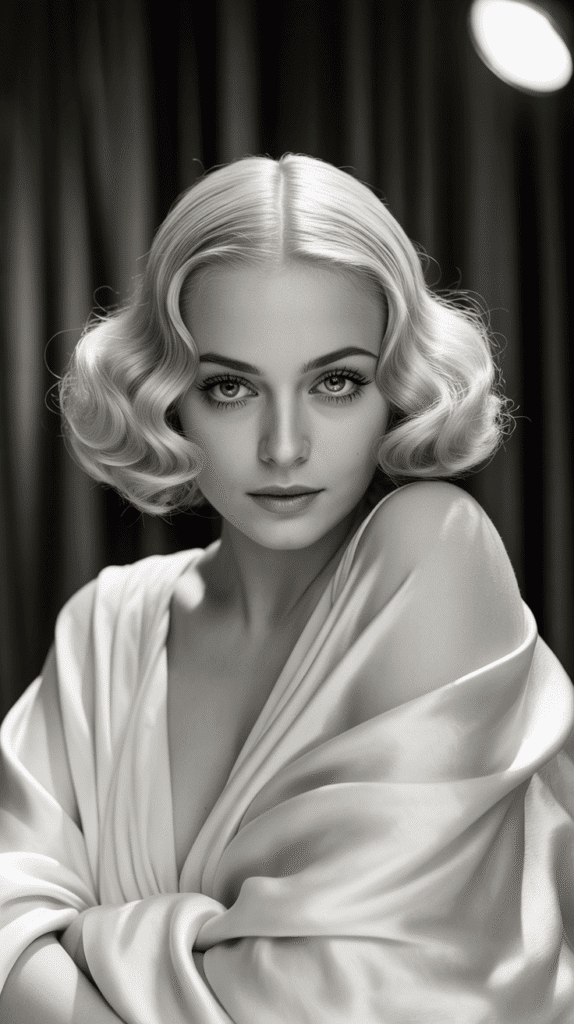
The center part with sculpted waves offered a balanced, symmetrical alternative to the dramatic side part, creating a classic look that emphasized facial symmetry and highlighted the carefully constructed wave patterns on both sides.
This style conveyed understated elegance and timeless beauty.
- Hair was divided precisely down the center from forehead to crown, with equal sections of hair falling on each side to create perfect symmetry.
- Matching wave patterns were created on both sides, requiring considerable skill to ensure the waves mirrored each other exactly.
- This style worked beautifully for women with oval faces and balanced features, as the symmetry emphasized natural facial proportions.
- The waves typically began immediately adjacent to the part, with the first wave cresting about an inch from the part line.
- Multiple rows of waves—usually three to five—cascaded down each side, creating a rhythmic, sculptural quality reminiscent of art deco design.
- For longer hair, the waves continued past the ears and down toward the shoulders, maintaining consistent wave depth throughout.
- Evening versions of this style often featured tighter, more defined waves with higher shine, achieved through liberal application of brilliantine or pomade.
8. The Pageboy
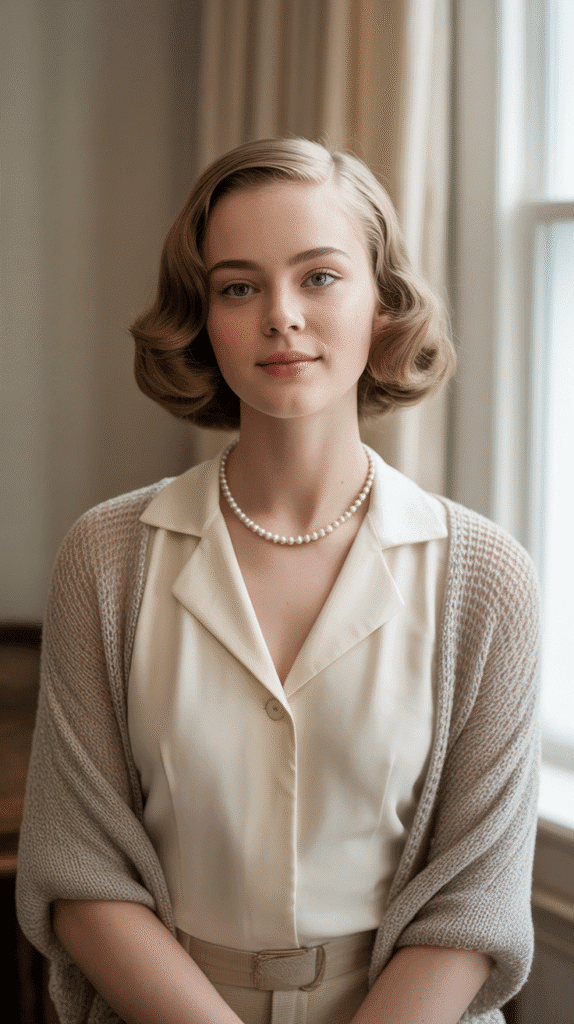
The pageboy emerged in the late 1930s as a youthful, modern alternative to more elaborate wave styles, featuring smooth hair that turned under in a uniform curl at the ends.
This style bridged the gap between the 1930s wave-dominated aesthetic and the smoother, more streamlined looks that would emerge in the 1940s.
- The pageboy length typically ranged from chin-length to shoulder-length, with hair cut in subtle layers to encourage the signature inward flip.
- Hair was set in large rollers or pin curls positioned to direct ends under rather than out or up, creating a smooth, rounded silhouette.
- The crown and sides were styled relatively smooth and flat, with the dramatic curve appearing only at the hair’s perimeter.
- This style gained popularity among younger women and college students who appreciated its fresh, clean-cut appearance and easier maintenance.
- Unlike heavily waved styles, the pageboy required less time to set and could be brushed into place more quickly each morning.
- Various interpretations existed, from very smooth, straight versions to those incorporating gentle waves through the length before the turned-under ends.
- The style particularly suited fine to medium hair textures that held the turn-under shape without excessive product or heat styling.
9. The Pompadour Style
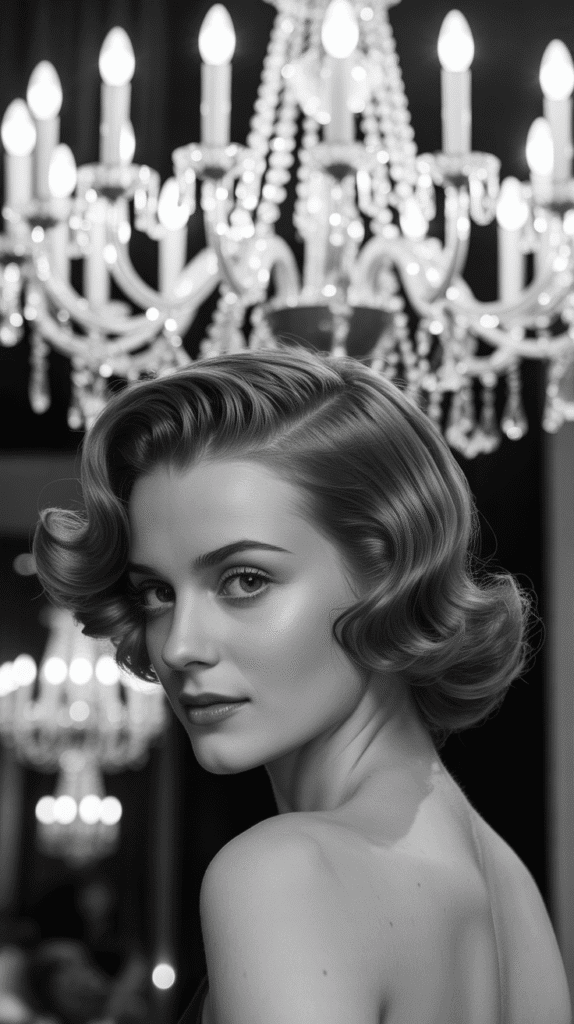
The 1930s pompadour involved sweeping front hair up and back from the forehead, creating height and volume before transitioning into waves or gathered styles at the back.
This technique added drama and elegance while showcasing the face beautifully.
- Front sections of hair were backcombed or teased to create interior support, then smoothed over the top to maintain a polished exterior appearance.
- The pompadour height varied from subtle lift to dramatic volume, depending on personal preference and the formality of the occasion.
- This front volume was typically combined with finger waves or marcel waves through the sides and back, creating a cohesive overall look.
- The style worked particularly well for women with higher foreheads, as the volume created balanced proportions and drew attention upward.
- Setting the pompadour required strategic pin curl placement underneath to maintain the lift, often using stacked curls or rolled sections.
- Hair was smoothed back from the face in a continuous sweep, avoiding any hard partings or divisions through the front section.
- Modern recreations benefit from volumizing products, teasing combs, and strong-hold hairspray to maintain the characteristic lift without period-authentic pomades.
10. Finger Wave Bob
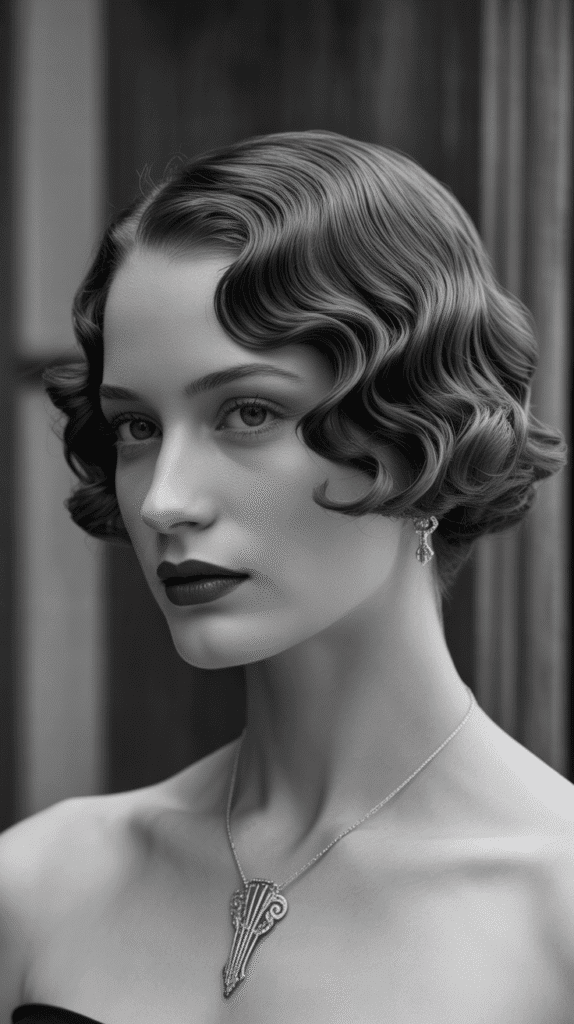
The finger wave bob combined the decade’s two most popular elements—the bob haircut and finger wave styling—creating a perfectly cohesive look that epitomized 1930s sophistication.
This style length offered versatility while maintaining the sculptural wave patterns that defined the era.
- Bob lengths ranged from chin-length to just above the shoulders, providing enough length to create multiple rows of finger waves while keeping a modern, manageable cut.
- Waves were created from root to tip, with the wave pattern continuing through the entire length of the hair for maximum visual impact.
- The nape area received special attention, with waves or pin curls arranged to create a finished look from all viewing angles.
- Shorter bobs featuring this technique appeared more casual and modern, while longer versions conveyed greater formality and sophistication.
- The wave pattern typically followed the head’s natural contours, with waves positioned horizontally through the sides and curving to follow the head shape at the back.
- This style required frequent trims to maintain the bob’s shape and ensure the waves fell correctly without straggly ends disrupting the pattern.
- The finger wave bob particularly suited women with strong facial features and good bone structure, as the style framed the face closely.
11. The Hollywood Wave
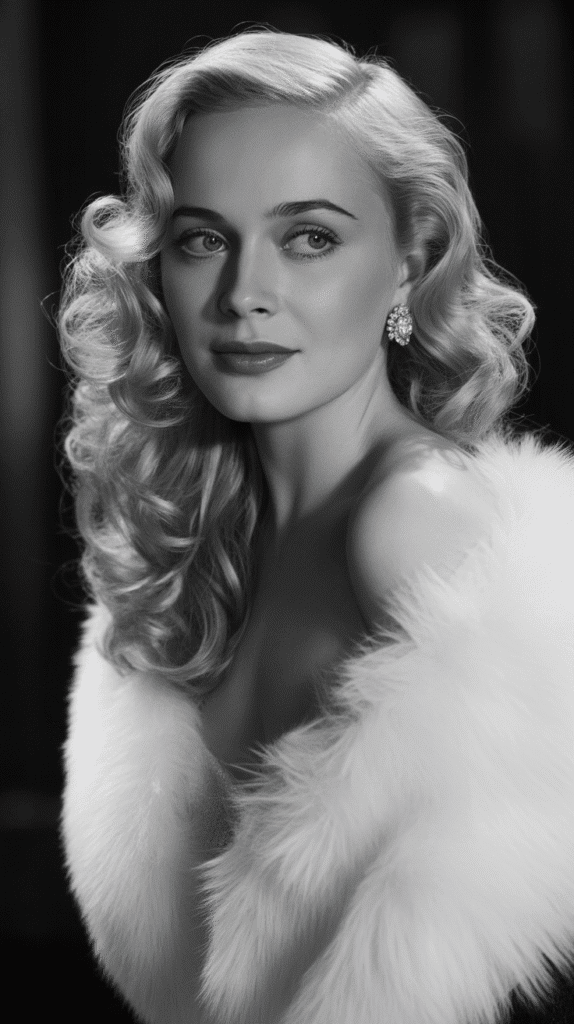
The Hollywood wave represented the glamorous, camera-ready styling perfected by studio hairstylists for film stars, featuring large, loose waves with exceptional shine and movement.
These waves appeared softer and more natural than structured finger waves while maintaining unmistakable elegance.
- Studio hairstylists created these waves using larger sections of hair and looser setting techniques, producing waves that moved fluidly and caught light beautifully on camera.
- The waves were positioned to flatter specific facial features, with hairstylists customizing wave placement to emphasize eyes, cheekbones, or jawlines.
- Excessive shine was achieved through liberal application of brilliantine, pomade, or hair oils that created the glossy appearance associated with silver screen glamour.
- These waves photographed exceptionally well in black and white film, with the interplay of light and shadow accentuating the wave depths.
- Hair was typically set in large pin curls or rollers, then carefully brushed and arranged to create seemingly effortless waves.
- The Hollywood wave suited medium to long hair lengths, with waves cascading romantically past the shoulders for maximum impact.
- Modern recreations can be achieved using large-barrel curling irons, setting methods with velcro rollers, and glossing serums for authentic shine.
12. The Braided Crown
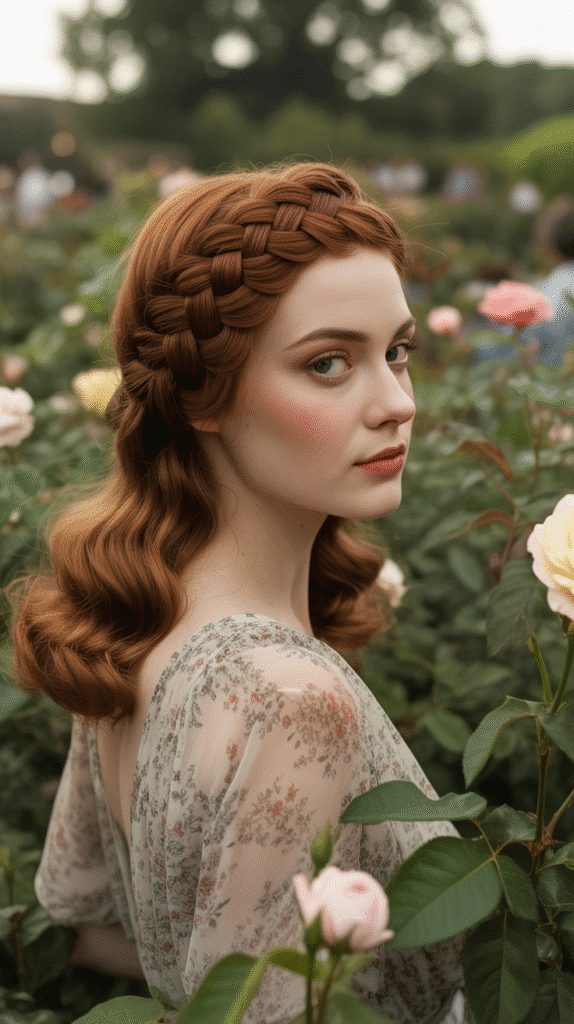
The braided crown represented a romantic, feminine styling option that incorporated braids into 1930s aesthetics, wrapping plaited hair around the head like a coronet.
This style offered a softer alternative to sculpted waves while maintaining period-appropriate sophistication.
- Hair was parted and sectioned, with one or two braids created from front sections and wrapped around the head’s crown area like a headband.
- The remaining hair was styled in waves, curls, or gathered into low arrangements at the nape, creating contrast between the structured braid and softer elements.
- This style worked particularly well for daytime wear and outdoor occasions, as the secured braid maintained its shape better than loose waves.
- Braided crowns appeared in various widths, from narrow, rope-like plaits to wider, flatter braids that created more dramatic visual impact.
- The style suited women with longer hair who desired elegant updos without the severity of completely slicked-back arrangements.
- Flowers, ribbon, or small jeweled pins were often woven into or pinned along the braided sections for added ornamentation.
- This versatile style bridged traditional and modern sensibilities, appealing to women who wanted vintage elegance with slightly more relaxed styling.
13. The Deep Side Sweep
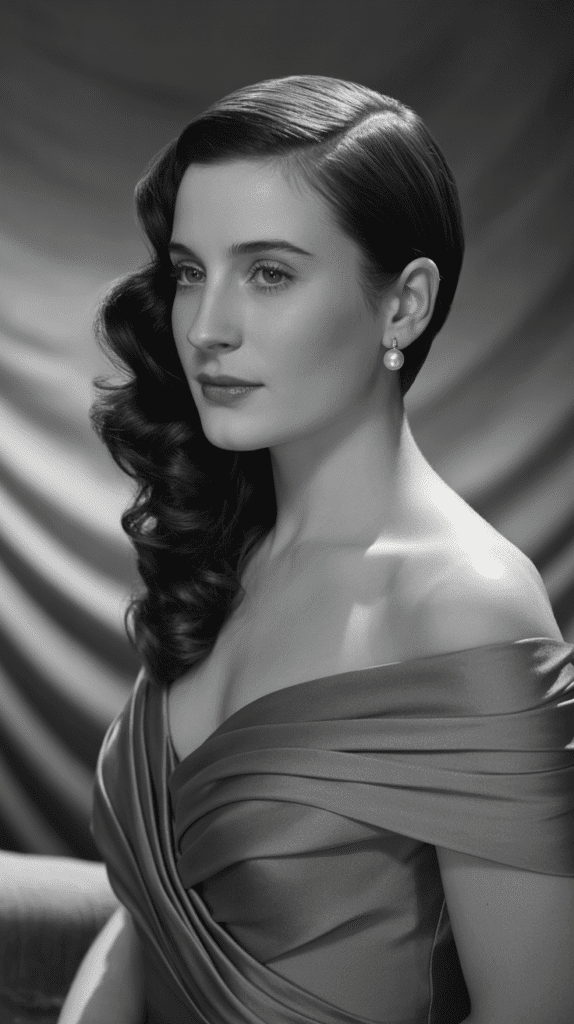
The deep side sweep created dramatic asymmetry by brushing nearly all hair to one side, securing it with pins or clips, and allowing it to cascade over one shoulder.
This style emphasized the decade’s love of asymmetrical design while showcasing beautiful wave patterns.
- Hair was parted extremely far to one side, typically just above one ear, with the vast majority of hair swept dramatically across the head.
- The small section on the part’s short side was styled flat against the head, often with a single wave or completely smooth, creating stark contrast.
- The large section featured multiple waves or curls cascading down past the shoulder, creating a waterfall effect of romantic movement.
- This style particularly suited evening wear and formal occasions, offering drama and visual interest appropriate for glamorous events.
- Securing the swept hair required numerous pins strategically placed along the head’s curve to prevent the heavy section from falling forward.
- The style drew attention to the neck and shoulder on the swept side, making it perfect for showcasing statement earrings or necklaces.
- Modern versions can be softened with looser waves and less product for a more wearable interpretation of the dramatic vintage look.
14. The Rolled Updo
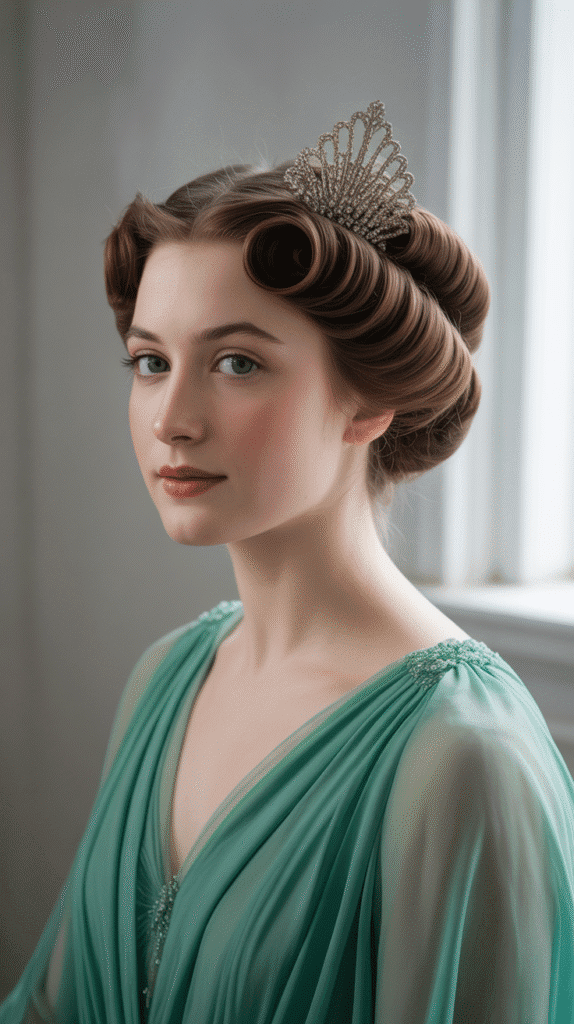
The rolled updo transformed longer hair into an elegant elevated style by rolling sections upward and pinning them into place, creating structured height and sophistication.
This technique represented a more architectural approach to 1930s hairstyling.
- Hair sections were systematically rolled upward from the nape toward the crown, with each roll pinned securely to create a stacked, layered effect.
- The front and sides typically featured smooth styling or gentle waves leading back toward the rolled sections, maintaining cohesion throughout the style.
- Various roll sizes created different visual effects, from numerous small rolls creating textured surfaces to fewer large rolls offering smooth, elegant curves.
- This style worked beautifully for special occasions like weddings, formal dinners, and theater outings where sophisticated elevation was appropriate.
- The technique required considerable length—at least shoulder-length hair or longer—to create rolls with sufficient volume and structure.
- Hair padding or rats (rolled hair mesh) were sometimes inserted inside the rolls to create more impressive height and fullness.
- The rolled updo could be customized with decorative combs, jeweled pins, or fresh flowers placed strategically among the rolled sections.
15. The Soft Wave Bob with Curled Ends
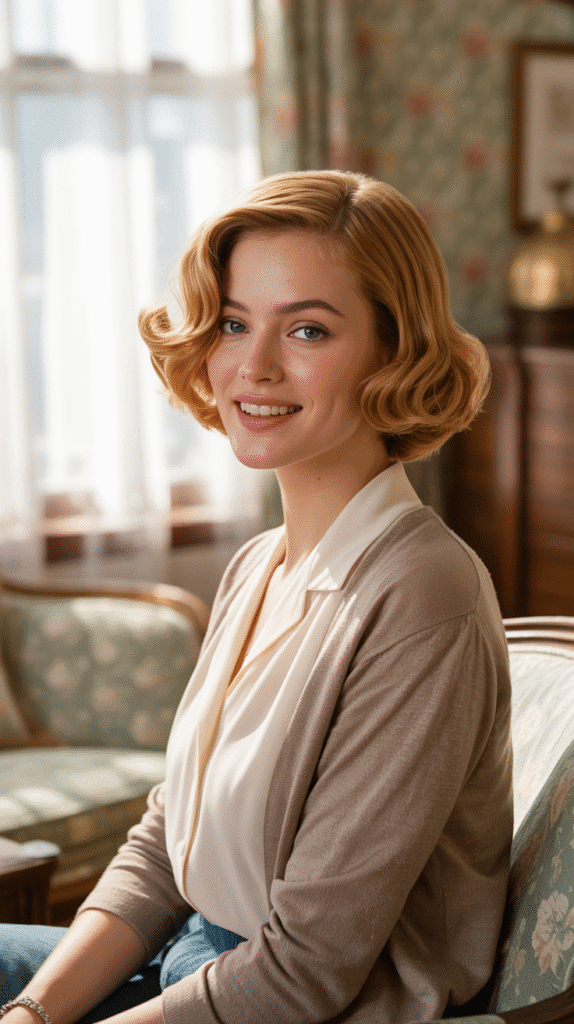
This romantic variation of the bob combined gentle waves through the length with curled or flipped ends, creating a softer, more approachable interpretation of 1930s styling.
The style bridged sophisticated wave techniques with youthful, accessible charm.
- Hair length fell between chin and shoulder, with subtle layers allowing ends to curl naturally under or flip outward depending on the desired effect.
- Rather than creating rigid finger waves, this style featured softer, more natural-looking waves achieved through pin curls or rag curls set overnight.
- The curled ends added a playful, feminine touch that differentiated this style from more severe geometric waves popular earlier in the decade.
- This approach worked beautifully for everyday wear, offering manageable styling that maintained period authenticity without requiring extensive daily maintenance.
- The soft waves photograph beautifully while appearing natural and effortless, making this style perfect for casual portraits and daily activities.
- Setting the style required large pin curls through the length, with the ends wrapped in specific directions to create the desired flip or curl.
- Modern recreations can be achieved quickly with large-barrel curling irons or hot rollers, then brushed through for authentic softness.
16. The Faux Bob
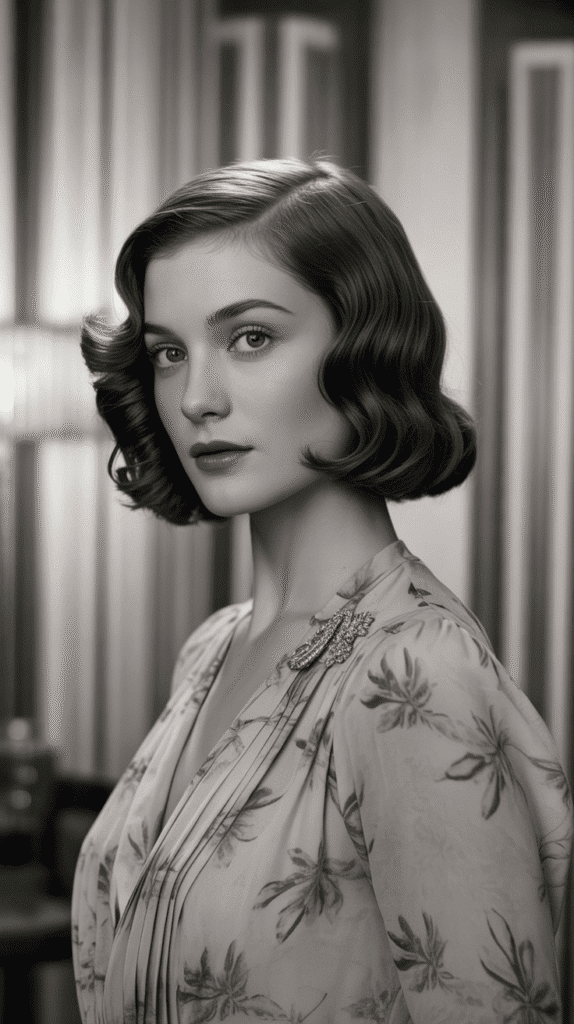
The faux bob allowed women with longer hair to achieve the fashionable bob silhouette without committing to a haircut, using pinning and tucking techniques to create the illusion of shorter hair.
This versatile styling option offered the best of both worlds.
- Long hair was arranged in pin curls or waves at the nape level, then the remaining length was tucked under and pinned securely to hide it completely.
- The resulting appearance mimicked a genuine bob, with hair seemingly ending at chin or shoulder length while the actual length remained intact underneath.
- Front and side sections received standard 1930s wave styling, creating seamless integration between the visible styled sections and the hidden tucked portion.
- This technique proved particularly popular among women who wanted fashionable styling options for special occasions while maintaining long hair for everyday wear.
- Creating a convincing faux bob required careful pinning to ensure the tucked section remained secure and invisible throughout wear.
- The style worked best on hair with sufficient length—at least mid-back or longer—to create the volume and shape characteristic of period bobs.
- Decorative combs, clips, or ribbon were often positioned at the nape to both secure the tucked section and add ornamental interest.
17. The High Finger Wave
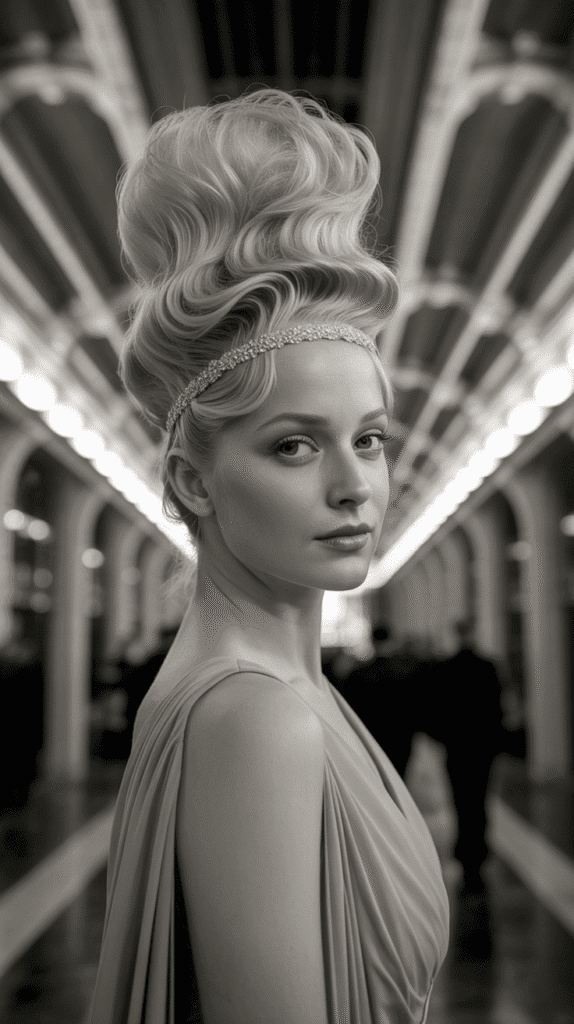
The high finger wave elevated the traditional finger wave technique by positioning waves higher on the head, creating vertical emphasis and dramatic height.
This styling approach added architectural interest while maintaining the sculptural qualities of standard finger waves.
- Waves began immediately at the hairline and continued upward toward the crown, creating lifted, voluminous styling rather than flat, horizontal patterns.
- The increased height required more substantial setting techniques, often involving elevated pin curls or rolled sections underneath the visible waves.
- This variation particularly suited formal evening occasions where dramatic, eye-catching styling was appropriate and expected.
- The vertical emphasis created an elongating effect, making this style flattering for women with round faces who wanted to appear taller and slimmer.
- Setting the high finger wave required more time and product, as the elevated sections needed significant support to maintain their height throughout wear.
- The style worked best on short to medium-length hair, as longer lengths created excessive weight that pulled down the carefully constructed elevation.
- Modern attempts should incorporate volumizing products at the roots and strategic backcombing to provide the necessary support for this lifted variation.
18. The Cluster Curl Style
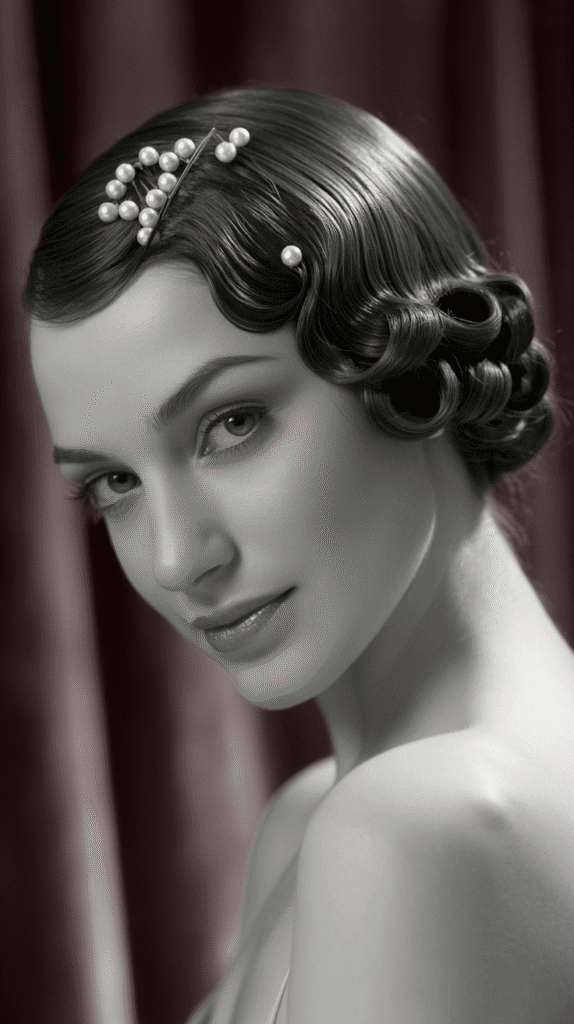
The cluster curl style featured groups of pin curls arranged decoratively on the head, creating textured, dimensional styling that offered contrast to smooth finger waves.
This technique added playful, romantic elements to formal 1930s hairstyling.
- Small sections of hair were curled and pinned in specific patterns, with clusters positioned at temples, crown, or nape areas for strategic visual impact.
- The curls remained somewhat separate and defined rather than being brushed out completely, showcasing individual curl shapes and creating texture.
- This styling approach worked particularly well for shorter hair that lacked sufficient length for elaborate wave patterns or updos.
- Cluster curls were often combined with smooth, flat sections elsewhere on the head, creating intentional contrast between textured and sleek areas.
- The technique allowed for creative personalization, with women arranging curl clusters in patterns that suited their facial features and personal aesthetics.
- For evening events, these clusters might be adorned with small jeweled pins, pearls, or fresh flower buds inserted among the curls.
- The style required less precision than rigid finger waves, making it more accessible for women styling their own hair at home.
19. The Asymmetrical Wave
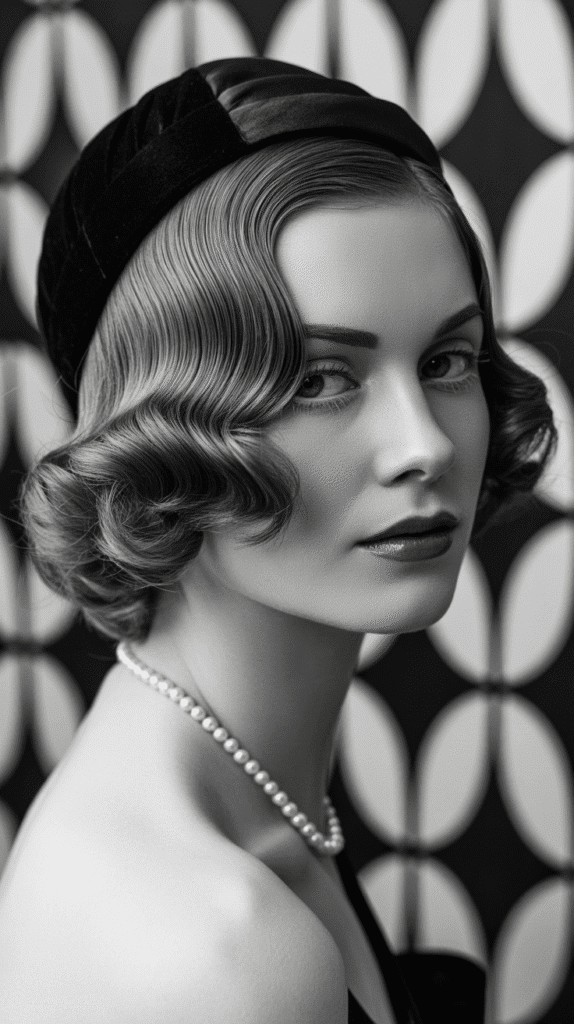
The asymmetrical wave style intentionally created different wave patterns on each side of the head, embracing the decade’s appreciation for dramatic asymmetry.
This bold approach allowed creative expression while maintaining sophisticated, polished execution.
- One side might feature tight, multiple finger waves while the other displayed looser, larger marcel waves, creating intentional contrast and visual interest.
- The asymmetry extended to wave direction as well, with waves on one side flowing forward toward the face while the other side’s waves moved backward.
- This style required considerable skill to execute successfully, as the different patterns needed to appear intentional rather than accidental or poorly executed.
- Asymmetrical styling allowed women to showcase their best features by customizing wave placement to flatter specific facial characteristics.
- The bold nature of this style suited confident, fashion-forward women willing to embrace avant-garde approaches to beauty and styling.
- Creating successful asymmetry required planning the overall design before beginning the setting process, mapping out where each pattern would appear.
- Modern interpretations can soften the contrast between sides while maintaining the underlying asymmetrical concept for wearable contemporary styling.
20. The Wrapped Chignon
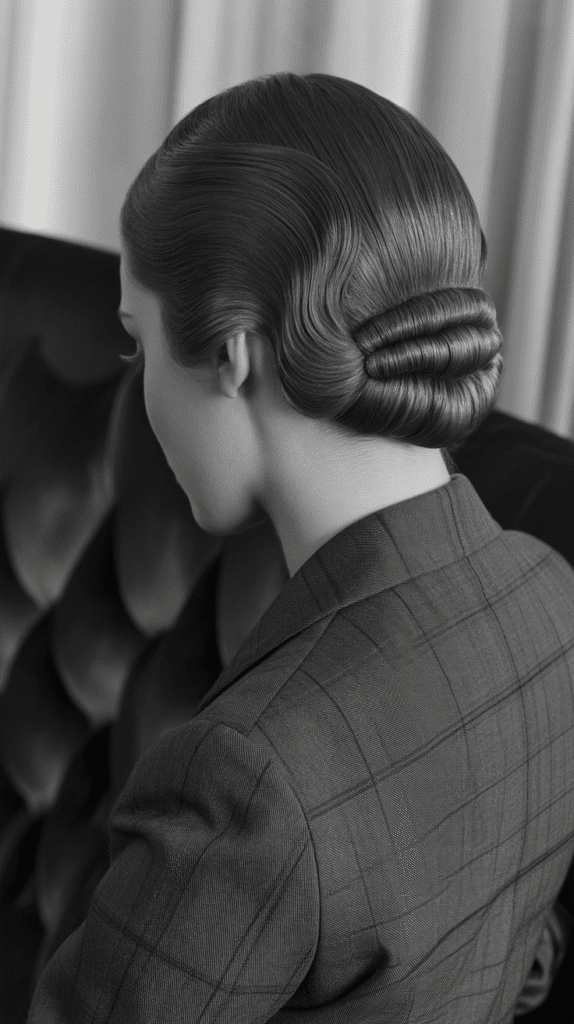
The wrapped chignon created a sophisticated low bun by wrapping hair around a central point in a spiral pattern, producing a neat, geometric arrangement at the nape.
This polished updo exemplified 1930s emphasis on clean lines and structured beauty.
- Hair was gathered at the nape and divided into sections that were individually wrapped around a central anchor point in overlapping layers.
- Each wrapped section was pinned securely, building up a rounded, dimensional bun with visible spiral patterns creating surface interest.
- The crown and sides leading into the chignon typically featured smooth styling or subtle waves, allowing the wrapped detail to serve as the style’s focal point.
- This technique worked beautifully for professional settings and formal daytime occasions where refined, understated elegance was appropriate.
- The wrapped chignon suited all hair lengths from shoulder-length to very long, though longer hair created fuller, more impressive finished results.
- Hair nets in matching colors were often positioned over the completed chignon to maintain security and create an even smoother, more polished appearance.
- Decorative elements like jeweled bobby pins or small combs could be inserted into the wrapped sections for evening wear adaptations.
21. The Waterfall Wave
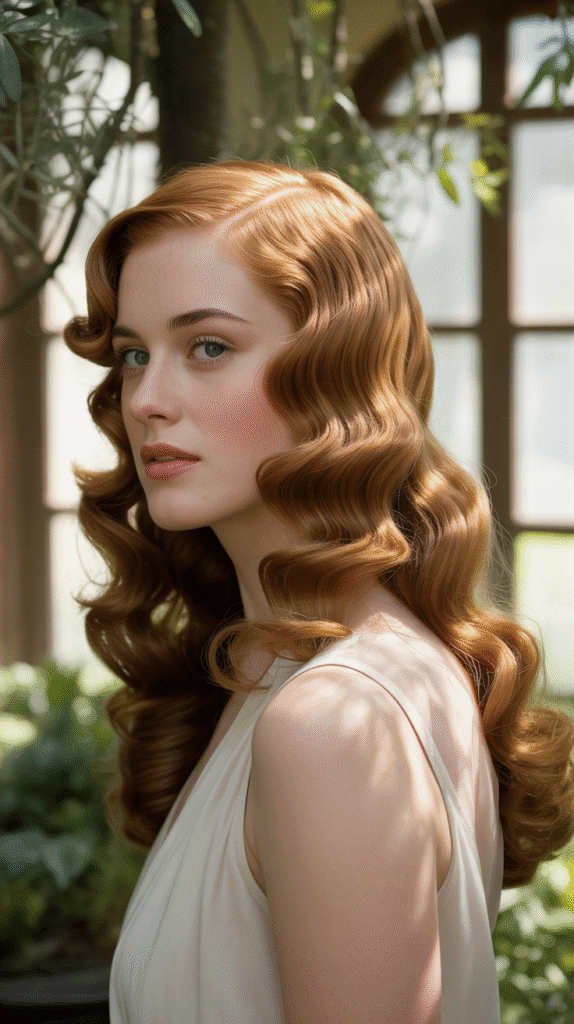
The waterfall wave created a cascading effect with waves flowing downward in graduated sizes, mimicking the appearance of falling water.
This romantic styling technique worked beautifully on longer hair and showcased movement and dimension.
- Waves were created in descending sizes, with smaller, tighter waves near the crown gradually transitioning to larger, looser waves through the length.
- The graduated sizing created natural-looking flow and movement, avoiding the rigid uniformity of traditional finger waves while maintaining structure.
- This technique required careful planning during the setting process, with pin curl sizes intentionally varied to create the graduated wave effect.
- The waterfall wave particularly suited women with long hair who wanted to showcase their length while incorporating fashionable wave styling.
- This style photographed beautifully, with the varied wave sizes creating depth and dimension that translated well in portraits.
- The technique worked with both center and side parts, though side parts emphasized the cascading effect more dramatically.
- Modern recreations can use varied curling iron barrel sizes or different roller sizes during setting to achieve the characteristic graduated waves.
22. The Sleek Middle Part
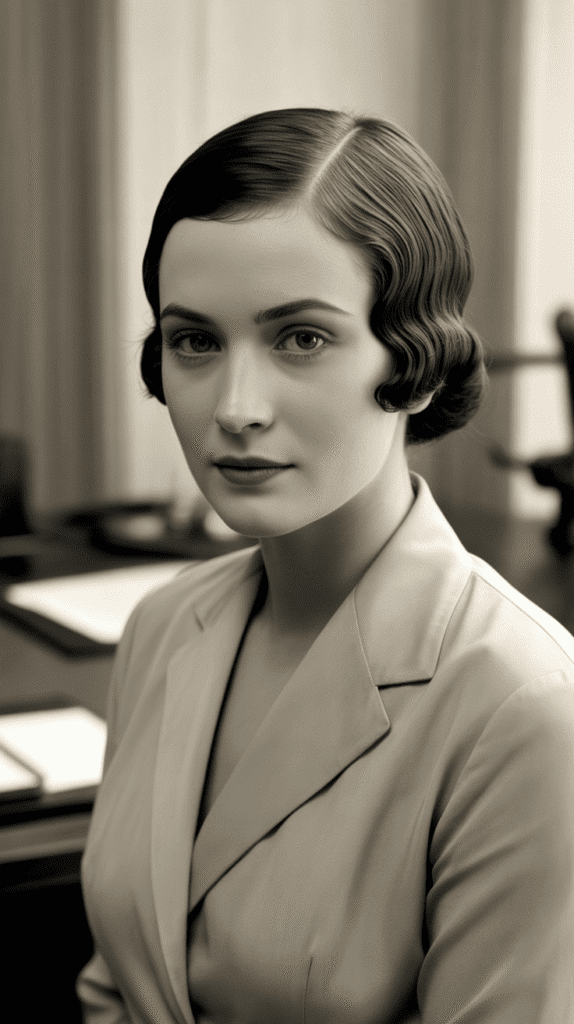
The sleek middle part offered a minimalist approach to 1930s styling, featuring hair parted precisely down the center with smooth, flat styling and minimal wave emphasis.
This understated elegance suited conservative preferences and daytime professionalism.
- Hair was parted with razor precision down the center from forehead to crown, with extreme care taken to ensure perfect symmetry.
- Rather than sculptural waves, hair was brushed smooth and flat against the head, with only the slightest natural wave or gentle curves through the length.
- This style particularly suited women with naturally straight or slightly wavy hair that achieved smooth styling without excessive product or heat.
- The sleek approach worked beautifully for oval and heart-shaped faces, as the clean center part and smooth styling emphasized natural facial proportions.
- Hair could be worn down, gathered into low ponytails, or arranged in simple buns while maintaining the characteristic sleek, smooth top sections.
- This minimalist styling represented the more understated end of 1930s fashion, appealing to women who preferred subtle elegance over dramatic flair.
- The style required regular maintenance and smoothing products to combat frizz and maintain the signature glassy-smooth appearance throughout wear.
23. The Halo Braid
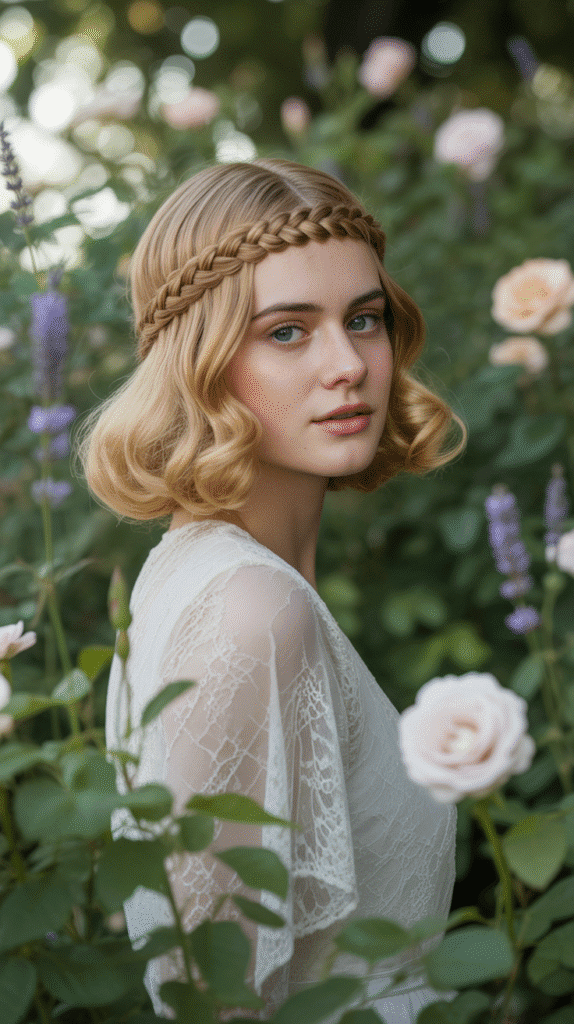
The halo braid created a crown-like effect by braiding hair and wrapping it around the head’s perimeter, combining the decade’s love of braided elements with elegant structural styling.
This romantic updo suited both casual and formal occasions depending on execution and accessories.
- Hair was divided and braided into one or two sections, then wrapped around the head like a headband or crown positioned slightly back from the hairline.
- The remaining hair below the halo braid could be arranged in various ways—left down in waves, gathered into low buns, or styled in pin curls at the nape.
- This style worked particularly well for women with thick, long hair that created substantial, impressive braids rather than thin, wispy ones.
- The halo braid suited outdoor occasions and daytime wear, as it secured hair effectively while maintaining romantic, feminine aesthetics.
- Variations included positioning the braid higher toward the crown for more dramatic effect or lower toward the nape for subtle elegance.
- Flowers, ribbon, or decorative pins could be woven into or positioned along the braid to enhance the crown-like appearance for special occasions.
- Modern recreations often incorporate looser, more textured braiding techniques for softer results while maintaining the characteristic wrapped positioning.
24. The Side-Swept Updo
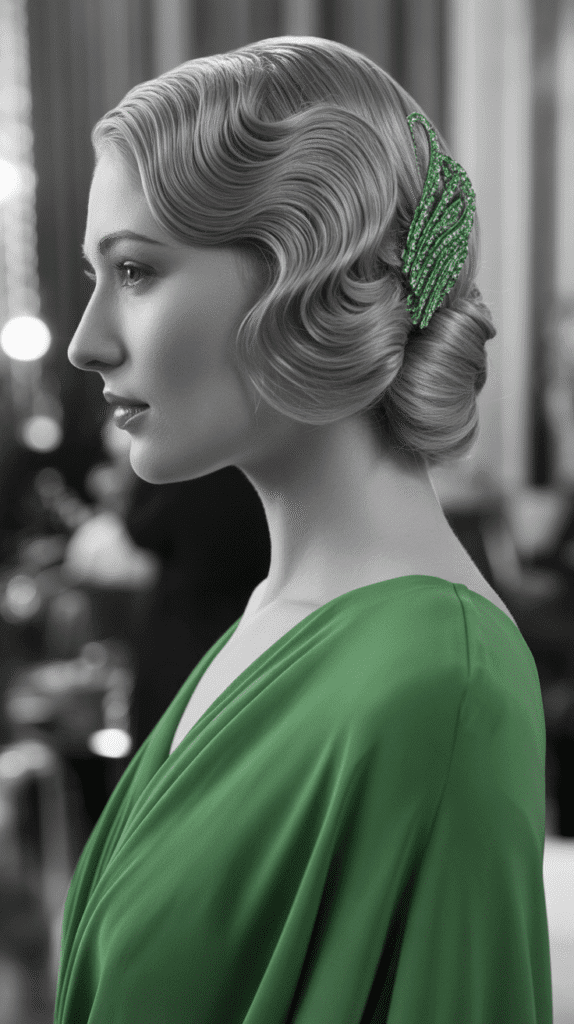
The side-swept updo combined dramatic side-swept front sections with gathered back hair, creating an elegant style that showcased both wave techniques and updo construction.
This versatile approach suited various occasions from professional settings to evening events.
- Front hair was swept dramatically to one side, styled in waves or smooth curves, then transitioned into gathered sections at the side or back of the head.
- The gathered portion was arranged in various configurations—twisted, rolled, or pinned into decorative patterns—creating visual interest at the style’s focal point.
- This approach allowed women to showcase beautiful earrings and facial features while maintaining sophisticated, secure styling appropriate for active days.
- The asymmetrical front sweep could be positioned to minimize facial flaws or emphasize best features, offering customizable flattering effects.
- Setting this style required strategic pin curl placement through the swept section to maintain the directional flow and prevent hair from falling forward.
- The gathered back section could be accessorized with decorative combs, jeweled clips, or fresh flowers depending on the occasion’s formality.
- This style worked on medium to long hair, with longer lengths offering more options for elaborate gathered arrangements at the back.
25. The Soft Brush-Out Wave
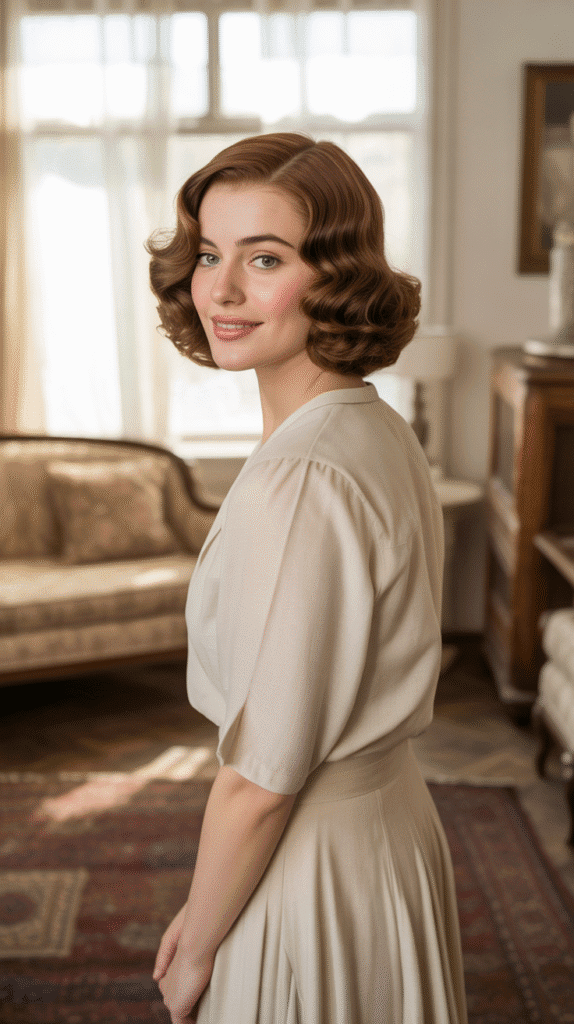
The soft brush-out wave created a more casual, natural-looking interpretation of 1930s waves by setting hair in pin curls or rollers, then brushing the results thoroughly to soften and blend the wave patterns.
This approach suited everyday wear and more relaxed occasions.
- Hair was set using traditional techniques but with larger sections and looser tension, creating less rigid wave patterns from the start.
- After setting and drying, hair was brushed extensively with natural bristle brushes, breaking up defined waves into softer, more blended movements.
- The resulting style maintained the era’s characteristic volume and shape while appearing more natural and less sculptural than formal finger waves.
- The soft brush-out worked beautifully for casual social occasions, shopping trips, and afternoon activities where polished but not dramatic styling was appropriate.
- Hair could be set in various patterns—horizontal, vertical, or diagonal—with the brushing process creating similar soft results regardless of initial setting direction.
- Modern recreations achieve this look easily by setting hair in hot rollers or velcro rollers, cooling completely, then brushing thoroughly for authentic softness.
26. The Crown Roll with Curls
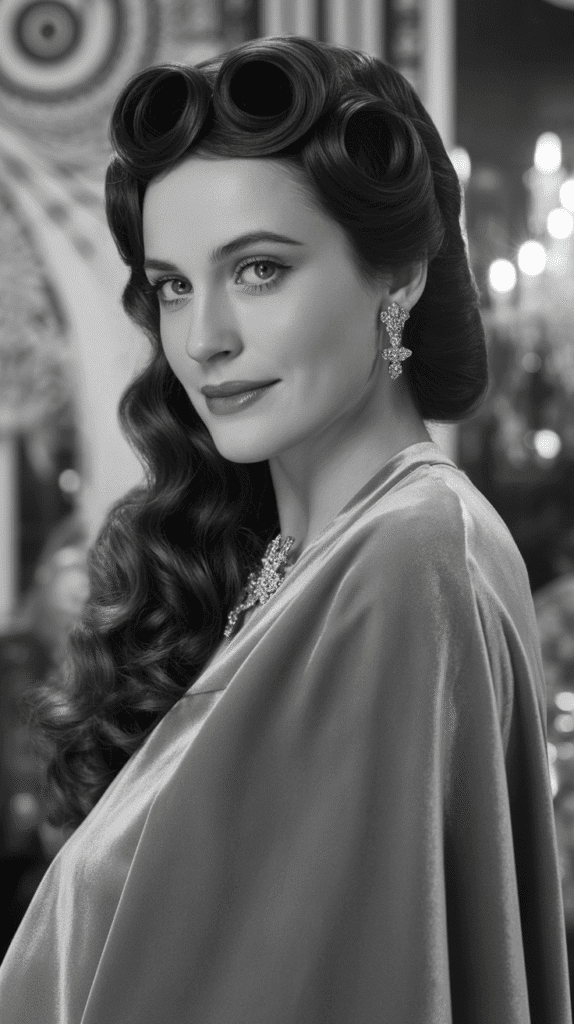
The crown roll with curls combined structured rolled sections positioned around the crown area with loose curls cascading down, creating a style that balanced architectural structure with romantic movement.
This hybrid approach showcased multiple styling techniques in one cohesive look.
- Hair at the crown and upper sections was rolled upward and pinned to create height and structure, forming a foundation for the overall style.
- The remaining hair below the rolled sections was styled in loose pin curls or marcel waves that hung freely, creating contrast between the secured upper portions and flowing lower sections.
- This style worked particularly well for medium to long hair, as sufficient length was needed to create both the crown rolls and the cascading curls below.
- The rolled crown created flattering height that elongated the face and added drama, while the loose curls below maintained feminine softness.
- Setting this style required dividing hair into distinct zones—upper sections for rolling and lower sections for curls—with each area receiving appropriate technique.
- The crown rolls could vary in size and number, from a single substantial roll to multiple smaller rolls creating more complex patterns.
- Evening versions featured tighter, more defined curls below the crown rolls, often with added shine products to enhance glamour and light reflection.
27. The Romantic Low Waves
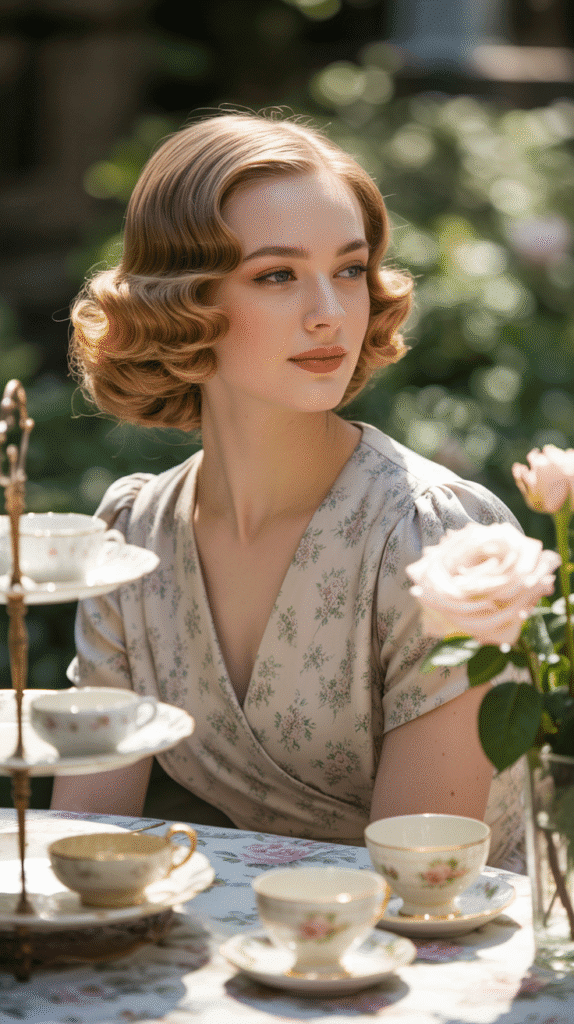
The romantic low waves style featured soft, flowing waves positioned primarily from mid-length downward, with smoother styling through the crown and top sections.
This approach created a dreamy, feminine aesthetic perfect for romantic occasions and soft, approachable everyday styling.
- The top and crown sections were styled relatively flat and smooth, often with a simple side or center part and minimal wave emphasis through these areas.
- Waves began appearing around ear level and increased in definition through the length, creating a gradual transition from smooth to textured styling.
- This technique worked beautifully on shoulder-length to long hair, as sufficient length was needed to showcase the flowing wave patterns effectively.
- The romantic low waves suited women who wanted to soften their appearance without the severity of all-over structured waves or completely smooth styles.
- Setting involved using larger pin curls or rollers through the lower sections while keeping top sections smooth with minimal setting or just light brushing.
- This style appeared effortless and natural despite requiring careful setting and styling, embodying the era’s appreciation for beauty that seemed uncontrived.
- The romantic aesthetic suited tea dresses, floral prints, and softer fashion choices popular during the mid-to-late 1930s as styles gradually softened.
Essential Styling Products and Tools
To successfully recreate these 1930s hairstyles with modern techniques, certain products and tools prove invaluable for achieving authentic results while protecting contemporary hair.
- Setting lotion or mousse: Provides the hold necessary for waves and curls to maintain their shape, replacing period-authentic sugar water or gum arabic solutions.
- Fine-toothed combs: Essential for creating precise parts and shaping finger waves, with metal combs offering better control than plastic alternatives.
- Wave clips or pin curl clips: Hold waves and curls in place during the drying and setting process, with metal clips providing superior grip.
- Bobby pins and hairpins: Secure updos, pin curls, and various style elements, with vintage-style crimped bobby pins offering better hold than smooth modern versions.
- Marcel irons or curling irons: Create heat-styled waves and curls, with various barrel sizes producing different wave depths and curl patterns.
- Hair rollers: Offer gentler setting alternatives to heat styling, with sizes ranging from small for tight curls to large for soft waves.
- Hairnets: Secure updos and protect elaborate styles during sleep or daily activities, available in various colors to match hair tones.
- Brilliantine or shine serum: Creates the characteristic glossy appearance of 1930s styling, though modern serums work better for contemporary chemically-treated hair.
- Strong-hold hairspray: Maintains finished styles throughout wear, replacing period-authentic lacquers that contained harmful ingredients.
- Teasing brush or rattail comb: Creates interior volume for pompadours, rolls, and styles requiring height and structure at the roots.
Adapting 1930s Styles for Modern Hair
Contemporary hair presents different challenges than 1930s hair due to chemical treatments, heat styling damage, and varied textures, requiring thoughtful adaptations of vintage techniques.
- Chemically treated hair: Modern coloring, bleaching, and chemical straightening affect hair’s ability to hold styles, often requiring additional products and modified techniques.
- Heat protection: Always apply heat protectant sprays before using hot tools, as period techniques didn’t account for cumulative heat damage from frequent styling.
- Texture considerations: Naturally curly or coily hair requires different setting approaches, often needing smoothing or straightening steps before creating 1930s wave patterns.
- Length modifications: Many 1930s techniques work beautifully on shorter modern cuts with slight adjustments to wave size and setting patterns.
- Product substitutions: Modern styling products offer better hold and hair health than period options, though application amounts may need adjustment for authentic results.
- Time-saving approaches: Hot tools can replicate overnight setting results in minutes, making vintage styling more accessible for contemporary schedules.
- Maintenance strategies: Modern dry shampoo and texturizing sprays extend style life between washings, similar to how 1930s women maintained styles for days.
- Customization for face shapes: The same principles of flattering specific features apply today, allowing personalization of vintage styles for individual faces.
Styling Tips for Long-Lasting Results
Achieving authentic 1930s hairstyles represents only half the challenge; maintaining these elaborate styles throughout wear requires specific strategies and care.
- Start with clean, slightly damp hair for setting, as product adheres better and distributes more evenly through freshly washed hair.
- Apply setting products generously but not excessively, ensuring even distribution from roots to ends for consistent hold throughout.
- Allow sets to dry completely before removing pins or clips, as removing them from damp hair causes waves to drop and lose definition.
- Sleep on silk or satin pillowcases to reduce friction that disturbs waves and causes frizz, preserving styles for multiple days.
- Use hairnets at night to protect elaborate updos and prevent loosening of pinned sections during sleep.
- Refresh flattened waves with dampened fingers and re-pinning, allowing refreshed sections to dry before releasing.
- Apply light hairspray throughout the day to combat humidity and maintain crisp wave definition in challenging weather.
- Avoid touching or running fingers through styled waves, as oils from hands disrupt patterns and reduce hold over time.
- Schedule important events for day two or three after setting when waves have settled and softened into their most beautiful, natural-looking state.
Historical Context and Cultural Significance
Understanding the historical context surrounding 1930s hairstyles enriches appreciation for these elegant styles and their enduring influence on beauty culture.
- The 1930s spanned the Great Depression, when women sought affordable glamour and styling techniques that could be maintained at home rather than in expensive salons.
- Hollywood’s golden age profoundly influenced popular hairstyling, with film stars setting trends that everyday women rushed to emulate through magazine tutorials and newsreel demonstrations.
- The decade marked a shift toward more feminine, romantic styling after the boyish, androgynous looks of the 1920s, reflecting changing attitudes about women’s roles and femininity.
- Hairstyling served as an accessible form of self-expression and morale-boosting during economically challenging times, offering women control over their appearance when other luxuries were unaffordable.
- The emphasis on waves and curls reflected the art deco movement’s appreciation for curved lines, geometric patterns, and decorative artistry applied to personal aesthetics.
- Professional hairstyling emerged as a respected career path for women during this era, with beauty schools and training programs expanding to meet demand for skilled stylists.
- Innovations in hair products and tools during the 1930s made elaborate styling more accessible, with new marcel irons, setting solutions, and permanents changing the hairstyling landscape.
- These styles represented a form of aspiration and escapism, allowing women to embody Hollywood glamour and sophistication regardless of their economic circumstances.
Conclusion
27 Classic 1930s Hairstyles That Bring Vintage Glamour Back celebrates an era when hairstyling elevated everyday beauty into an art form, transforming simple techniques like waves, rolls, and pin curls into sophisticated expressions of femininity and elegance.
The enduring appeal of these styles lies in their versatility, ranging from the dramatic finger waves that defined formal occasions to the soft brush-out waves perfect for casual wear, offering options suitable for every preference and skill level.
Modern beauty enthusiasts continue discovering that these vintage techniques translate beautifully to contemporary styling, whether recreating authentic period looks for special events or adapting elements into modern hairstyles that nod to vintage inspiration.
The practical knowledge shared in this comprehensive guide—from foundational pin curl techniques to elaborate updo constructions—empowers readers to explore these timeless styles with confidence and creativity.
As you experiment with these classic 1930s hairstyles, remember that the true essence of this era’s beauty philosophy centered on taking time for self-care and finding joy in the artistry of personal grooming, values that remain profoundly relevant in today’s fast-paced world.
Whether you choose to master the sculptural perfection of finger waves or embrace the romantic softness of low waves, each style connects you to a rich legacy of women who understood that glamour isn’t about perfection but about the confidence that comes from feeling beautiful.
The techniques, tips, and inspiration provided here serve as your gateway to exploring vintage glamour, proving that with patience, practice, and the right approach, anyone can bring the sophisticated elegance of 1930s hairstyling into their modern beauty repertoire.